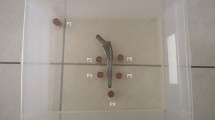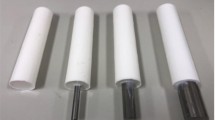Abstract
Objective
To assess the usefulness of gemstone spectral imaging (GSI) dual-energy CT (DECT) with/without metal artefact reduction software (MARs).
Methods
The DECTs were performed using fast kV-switching GSI between 80 and 140 kV. The CT data were retro-reconstructed with/without MARs, by different displayed fields-of-view (DFOV), and with synthesised monochromatic energy in the range 40–140 keV. A phantom study of size and CT numbers was performed in a titanium plate and a stainless steel plate. A clinical study was performed in 26 patients with metallic hardware. All images were retrospectively reviewed in terms of the visualisation of periprosthetic regions and the severity of beam-hardening artefacts by using a five-point scale.
Results
The GSI-MARs reconstruction can markedly reduce the metal-related artefacts, and the image quality was affected by the prosthesis composition and DFOV. The spectral CT numbers of the prosthesis and periprosthetic regions showed different patterns on stainless steel and titanium plates.
Conclusion
Dual-energy CT with GSI-MARs can reduce metal-related artefacts and improve the delineation of the prosthesis and periprosthetic region. We should be cautious when using GSI-MARs because the image quality was affected by the prosthesis composition, energy (in keV) and DFOV. The metallic composition and size should be considered in metallic imaging with GSI-MARs reconstruction.
Key Points
• Metal-related artefacts can be troublesome on musculoskeletal computed tomography (CT).
• Gemstone spectral imaging (GSI) with dual-energy CT (DECT) offers a novel solution
• GSI and metallic artefact reduction software (GSI-MAR) can markedly reduce these artefacts.
• However image quality is influenced by the prosthesis composition and other parameters.
• We should be aware about potential overcorrection when using GSI-MARs.







Similar content being viewed by others
References
National Hospital Discharge Survey: survey results and products. Atlanta: Centers for Disease Control and Prevention, 2009. (Accessed May 5, 2011, at http://www.cdc.gov/nchs/nhds/nhds_products.htm. .
White LM, Buckwalter KA (2002) Technical considerations: CT and MR imaging in the postoperative orthopedic patient. Semin Musculoskelet Radiol 6:5–17
Barrett JF, Keat N (2004) Artifacts in CT: recognition and avoidance. Radiographics 24:1679–1691
Haramati N, Staron RB, Mazel-Sperling K et al (1994) CT scans through metal scanning technique versus hardware composition. Comput Med Imaging Graph 18:429–434
Love C, Marwin SE, Palestro CJ (2009) Nuclear medicine and the infected joint replacement. Semin Nucl Med 39:66–78
Buck FM, Jost B, Hodler J (2008) Shoulder arthroplasty. Eur Radiol 18:2937–2948
Gelman MI, Coleman RE, Stevens PM, Davey BW (1978) Radiography, radionuclide imaging, and arthrography in the evaluation of total hip and knee replacement. Radiology 128:677–682
Phillips WC, Kattapuram SV (1983) Efficacy of preoperative hip aspiration performed in the radiology department. Clin Orthop Relat Res 141–146
Young SW, Muller HH, Marshall WH (1983) Computed tomography: beam hardening and environmental density artifact. Radiology 148:279–283
Lee MJ, Kim S, Lee SA et al (2007) Overcoming artifacts from metallic orthopedic implants at high-field-strength MR imaging and multi-detector CT. Radiographics 27:791–803
Watzke O, Kalender WA (2004) A pragmatic approach to metal artifact reduction in CT: merging of metal artifact reduced images. Eur Radiol 14:849–856
Li H, Yu L, Liu X, Fletcher JG, McCollough CH (2010) Metal artifact suppression from reformatted projections in multislice helical CT using dual-front active contours. Med Phys 37:5155–5164
Li H, Yu L, Liu X, McCollough CH (2009) Metal artifact suppression from reformatted projections in multi-slice helical CT using dual-front active contours. Conf Proc IEEE Eng Med Biol Soc 2009:993–996
Yu L, Li H, Mueller J et al (2009) Metal artifact reduction from reformatted projections for hip prostheses in multislice helical computed tomography: techniques and initial clinical results. Invest Radiol 44:691–696
Link TM, Berning W, Scherf S et al (2000) CT of metal implants: reduction of artifacts using an extended CT scale technique. J Comput Assist Tomogr 24:165–172
Montner SM, Lehr JL, Oravez WT (1987) Quantitative evaluation of a dual energy CT system. J Comput Assist Tomogr 11:144–150
Dilmanian FA (1992) Computed tomography with monochromatic x rays. Am J Physiol Imaging 7:175–193
Dilmanian FA, Wu XY, Parsons EC et al (1997) Single-and dual-energy CT with monochromatic synchrotron x-rays. Phys Med Biol 42:371–387
Bamberg F, Dierks A, Nikolaou K, Reiser MF, Becker CR, Johnson TR (2011) Metal artifact reduction by dual energy computed tomography using monoenergetic extrapolation. Eur Radiol 21:1424–1429
Boas FE, Fleischmann D (2011) Evaluation of two iterative techniques for reducing metal artifacts in computed tomography. Radiology 259:894–902
Lin XZ, Miao F, Li JY, Dong HP, Shen Y, Chen KM (2011) High-definition CT Gemstone spectral imaging of the brain: initial results of selecting optimal monochromatic image for beam-hardening artifacts and image noise reduction. J Comput Assist Tomogr 35:294–297
Zhang D, Li X, Liu B (2011) Objective characterization of GE discovery CT750 HD scanner: gemstone spectral imaging mode. Med Phys 38:1178–1188
Douglas-Akinwande AC, Buckwalter KA, Rydberg J, Rankin JL, Choplin RH (2006) Multichannel CT: evaluating the spine in postoperative patients with orthopedic hardware. Radiographics 26:S97–S110
Acknowledgement
This study was supported by a faculty research grant of Yonsei University College of Medicine (6-2008-0223).
Author information
Authors and Affiliations
Corresponding author
Rights and permissions
About this article
Cite this article
Lee, Y.H., Park, K.K., Song, HT. et al. Metal artefact reduction in gemstone spectral imaging dual-energy CT with and without metal artefact reduction software. Eur Radiol 22, 1331–1340 (2012). https://doi.org/10.1007/s00330-011-2370-5
Received:
Revised:
Accepted:
Published:
Issue Date:
DOI: https://doi.org/10.1007/s00330-011-2370-5




